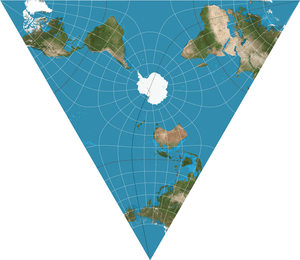Lee conformal world in a tetrahedron

_with_Tissot's_Indicatrices_of_Distortion.svg.png)

The Lee conformal world in a tetrahedron is a polyhedral, conformal map projection that projects the globe onto a tetrahedron using Dixon's elliptic functions. It is conformal everywhere except for the four singularities at the vertices of the polyhedron. Because of the nature of polyhedrons, this map projection can be tessellated infinitely in the plane. It was developed by L. P. Lee in 1965.[1]
Coordinates from a spherical datum can be transformed into Lee conformal projection coordinates with the following formulas,[1] where α is the longitude and σ the angular distance from the pole:
where
and "sm" and "cm" are Dixon's elliptic functions.
Since there is no way to directly compute these functions, Lee suggested the use of the 28th degree MacLaurin Series.[1]
See also
References